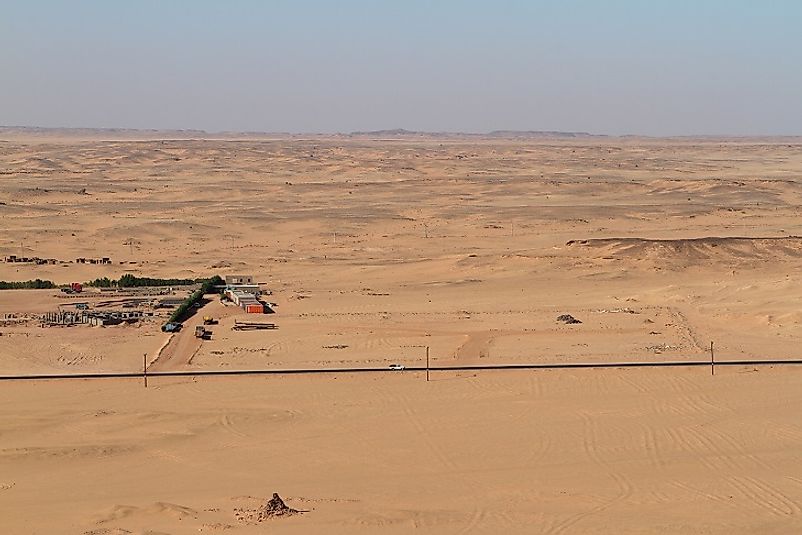Ecological Regions Of Sudan

The Republic of Sudan is located in the northeastern part of Africa and is bordered by Egypt, Eritrea, Ethiopia, South Sudan, the Central African Republic, and the Red Sea. Sudan is the third largest country in Africa and the 16th largest in the world with a land area of 1,886,068 square kilometers. The country’s terrain is flat with some mountain ranges. The River Nile is formed at Khartoum where the Blue and White Nile meet. The northern part of Sudan is dry and comprise of Nubian Desert. The rainy season lasts between July and September with a longer sunshine duration. Sudan is divided into three biome which make up several ecological regions. These ecoregions are looked at below.
Ethiopian Montane Forests
The Ethiopian Montane Forests are highly biodiverse but also greatly threatened. The ecoregion lies between 1,100 meters and 1,800 meters above sea level. The wind which brings rainfall blows southward from May to October. Rainfall varies from 600 millimeters to 1,500 millimeters with spontaneous higher humidity due to cloud precipitation. Temperatures also vary depending on the season and the level of elevation with a mean range of 12o Celsius and 24o Celsius. Some of the threatened species in this ecoregion include francolin species, yellow-throated Seedeater, and Prince Ruspoli’s turaco. Ethiopian Montane Forests ecological region is poorly protected with flora and fauna exposed to external threats. The natural habitats have been reduced to small patches which are severely fragmented. Agriculture and exploitation are the common threats to the region.
East Sudanian Savanna
The East Sudanian Savanna is a wooded savanna composed of Combretum and Terminalia shrub and tree species. Sudan’s East Sudanian Savanna forms the eastern bloc of the larger ecological region. The ecoregion is flat with an elevation of between 200 meters and 1,000 meters. The tropical climate of East Sudanian Savanna is characterized by a temperature range of 18o Celsius to 33o Celsius and an annual rainfall of 600 millimeters. The trees in this ecoregion lose their leaves during the dry season while the grass dries up and may burn. The mammal species found in this ecoregion include elephants, wild dogs, mouse, leopard, lion, black rhinoceros, and cheetah. There are also reptiles and amphibians living in this region. The ecoregion has over 2,700 plant species and 200 species of birds. Agriculture, herding, and poaching are the major threat to the ecoregion. Only 136,000 square kilometers are protected, and adequate enforcement is often not provided even within the protected areas.
Sahelian Acacia Savanna
The Sahelian Acacia Savanna stretches from Senegal to Sudan through Mauritania. The region is mainly flat and lies at an altitude of between 200 meters and 400 meters. The climate is tropical and seasonal with temperatures varying from 18o Celsius and 33o Celsius and average annual rainfall of between 200 millimeters and 600 millimeters. Rainfall is experienced during summer months of May to September. Sahelian Acacia Savanna is not rich in species. However, some of the endemic animals in this region include rodents, bat species, mouse, and birds. Large mammals like gazelles, cheaters, lions, and wild dogs are the endangered species in the ecoregion. The introduction of domestic animals like cattle and goats has reduced the access to water by some of the wildlife species. Agriculture and collection of firewood are also threats to the ecosystem.
Sudan shares most of its ecological regions with its neighboring countries, and within it areas including its northern, eastern, and central regions share the most similarities with its neighbors. Human activities such as cultivation, settlement, poaching and logging are some of the leading threats to the country’s ecological regions.
| Ecoregions of Sudan (as per World Wide Fund for Nature) | Biome |
|---|---|
| Ethiopian Montane Forests | Tropical and Subtropical Moist Broadleaf Forests |
| East Sudanian Savanna | Tropical and Subtropical Grasslands, Savannas, and Shrublands |
| Sahelian Acacia Savanna | Tropical and Subtropical Grasslands, Savannas, and Shrublands |
| Ethiopian Montane Grasslands and Woodlands | Montane Grasslands and Shrublands |
| East Saharan Montane Xeric Woodlands | Deserts and Xeric Shrublands |
| Ethiopian Xeric Grasslands and Shrublands | Deserts and Xeric Shrublands |
| Red Sea Coastal Desert | Deserts and Xeric Shrublands |
| Sahara Desert | Deserts and Xeric Shrublands |
| South Saharan Steppe and Woodlands | Deserts and Xeric Shrublands |
| Tibesti-Jebel Uweinat Montane Xeric Woodlands | Deserts and Xeric Shrublands |











